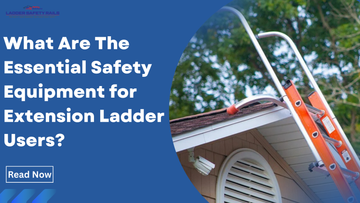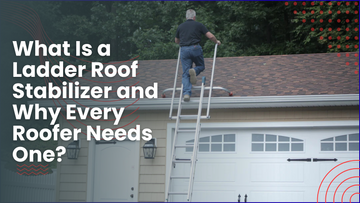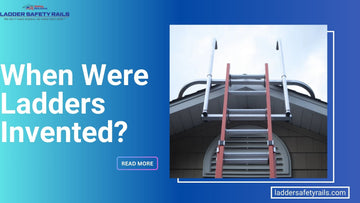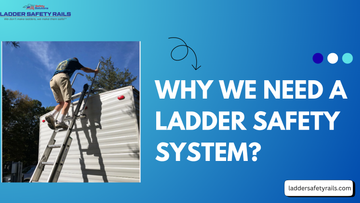
Essential safety equipment for extension ladder users isn't just about checking off a list; it’s about thinking of your life, and the people around you. If you’re cleaning out the gutters on a Sunday afternoon, painting the second story of your house, or working as a professional roofer or electrician, the risks are real.
The good news is that now, you don’t have to spend a fortune or reinvent the wheel to stay safe. From basic stabilizers to full-body harness systems, there’s a wide range of tools designed specifically for extension ladder safety.
In this guide, we’ll break down the must-have equipment for ladder users, so whether you’re climbing a 20-foot extension ladder, you can do it with confidence and control.
Ladder Stabilizers: A Simple Add-On That Changes Everything
One of the most game-changing tools you can add to your ladder setup is a ladder stabilizer. It may look like a simple bar that clips on the top of the ladder, but the safety benefits are amazing. By spreading the ladder’s weight over a larger surface area and improving grip at the top, stabilizers significantly reduce the chances of side-to-side tipping, one of the most common causes of ladder accidents.
If you’ve been up high and felt your ladder wiggle too much, you know how heart-stopping that moment can be. Especially when working with a tall 24-foot extension ladder, a small shift can feel like a rollercoaster drop. A stabilizer acts like an anchor, gripping the wall or roof more securely and giving you the confidence to focus on your work instead of worrying about balance. It also prevents the ladder from damaging fragile surfaces like gutters or siding, a major bonus if you care about your home’s appearance.
Many professionals consider a ladder safety device as an essential piece of gear, and once you start using one, you’ll understand why. It’s simple to install, doesn’t add much weight, and can make a big difference between a smooth project and a trip to the ER.
Non-Slip Ladder Feet: Your Ground-Level Lifesaver
We often focus so much on what's happening at the top of the ladder that we forget the most crucial point of contact is at the bottom. Your ladder is only as safe as the surface it's standing on, and that’s where non-slip ladder feet come into play. Their grippy, rubberized ends ensure your ladder stays properly, whether you're on wet grass, gravel, concrete, or slippery tiles.
Imagine you're using a safety ladder extension to access your roof, and the base is resting on damp soil after morning rain. Without proper footing, the most careful climb can turn dangerous. The ladder could shift mid-step, causing you to lose balance or, worst case, come crashing down. Quality non-slip feet help prevent this. Some models also feature articulating pads that adjust to uneven ground, giving you an extra layer of stability.
It may seem like a small upgrade, but when it comes to extension ladder safety, it starts with the foundation. Always check your ladder’s feet before starting your work. If they're worn, cracked, or missing altogether, replace them before you set foot. It's a fix that could save your life.
Harnesses and Tie-Offs: When Height Gets Serious

When you're working 20+ feet off the ground, whether you're on a 20-foot extension ladder cleaning gutters or trimming tree branches, a simple slip can have serious consequences. That’s where harnesses and tie-off systems come in. These fall protection tools are designed to catch you if you lose your balance or if the ladder shifts unexpectedly.
This kind of ladder safety system is often required on professional job sites and recommended for anyone working more than six feet off the ground. Sure, it takes a minute to strap in, but once you feel that secure connection, you’ll never want to step up without it again. And yes, it may look a bit overkill for a quick chore, but it's not good to argue with safety that works before something goes wrong.
Ladder Levelers: Tame the Uneven Terrain
Ever tried to balance a ladder on a slope, a set of stairs, or that rough patch of gravel by your house? It’s tricky and dangerous. That’s why ladder levelers are crucial to have. These adjustable feet attach to the base of your ladder and can help you compensate for uneven ground, making sure your ladder stays vertical when the terrain isn’t.
When you’re using a ladder to hang holiday lights on your sloped driveway. Without a leveler, one leg of the ladder slides deeper than the other, making you to make up for the imbalance with your body. That’s a recipe for a fall. A ladder leveler takes that risk off the table by giving each leg independent height adjustment.
They’re useful for outdoor tasks, where flat surfaces are not there. They’re also compatible with most major aluminum extension ladder brands, making them a versatile addition to your gear. Some come with quick-release mechanisms, so you can adjust them.
Long story short, if the ground isn’t flat, your ladder can still be, with the right equipment.
Accessory Trays and Tool Holders: Work Smart
When you climb halfway up a ladder, only to realize your drill is in your back pocket and your screws are still on the ground, it’s not just annoying, it’s unsafe. The more you fumble with tools, move around awkwardly, or constantly go up and down to grab gear, the risk of losing balance increases. That’s why accessory trays and tool holders are a smart for your extension ladder safety setup.
For jobs involving a 24-foot-long ladder, this is especially important. Going up and down constantly can lead to fatigue, and that can lead to mistakes. So if you’re doing this kind of work, it takes a little time to set up your ladder as a workstation. You’ll be safer, faster, and efficient.
Warning Labels and Inspection Tags: Know Before You Go Up
We all know, labels can be boring. But when it comes to ladder safety, the information printed on your ladder can prevent injury. Warning labels and inspection tags tell you everything from the ladder’s maximum load capacity to how it should be angled. Ignoring this information is like driving without checking your mirrors; it’s a gamble.
Let’s say you’re using a 20-foot extension ladder rated for 225 pounds. That might sound like plenty, until you add your tool belt, power drill, and a box of paint. Suddenly, you’re close to the limit, and the ladder’s integrity is compromised. Knowing your weight rating helps you stay within safe limits.
High-Visibility Clothing: Be Seen, Be Safe

Wearing bright or reflective clothing may not seem like a big deal until someone walks right into your ladder, as they didn’t notice you. If you’re working near roads, driveways, or just in your backyard where kids or neighbors are nearby, high-visibility gear is a perfect way to stay seen and stay safe.
Pair your aluminum extension ladder with a reflective vest or hat, especially during early morning or evening hours when visibility is low. This is more important on job sites, where equipment, people, and vehicles are moving. A quick flash of neon can be enough to alert someone that you’re up above.
It may feel like a burden for a quick task, but being visible is just another layer of protection. Safety isn’t just about preventing falls; it’s about making sure others don’t accidentally harm you.
Reliable Extension Ladder Choice: Get the Right Base
The truth is, no amount of add-ons can make up for an inferior ladder. The best ladder safety tips start with choosing the right ladder in the first place. A sturdy, well-maintained extension ladder with good quality construction should be your first choice and most important line of defense.
Choose trusted materials like fiberglass or aluminum with solid rungs and reliable locks. Choose a height that fits you without pushing limits.
Investing in a good ladder isn’t just a purchase, it’s a long-term commitment to your Ladder safety. Combine it with smart equipment, and you’ve got yourself.
Final Thoughts
Climbing ladders will always carry some risk, but with the right safety gear—stabilizers, harnesses, proper footwear, and tool trays—you can work with confidence. These aren’t just accessories; they’re essential for protection.
Looking for more tips and gear recommendations? Check out our full guide to must-have ladder safety tools.
And when you're ready to upgrade your setup, trust Ladder Safety Rails for reliable, real-world tested gear that puts your safety first. Visit us and shop now!
FAQs:
-
What items are mandatory for ladder securement?
Non-slip feet, a stabilizer, tie-off straps, and, for height work, a harness and anchor point are key for secure ladder use.
-
What are the safety requirements for using a ladder?
Set the correct angle, use three contact points, stay within weight limits, and inspect before use, follow all safety rules every time.
-
What is the OSHA violation of safe ladder use?
Common violations include damaged ladders, improper setup, overreaching, and missing fall protection or safety devices.
-
What is a general safety guideline for ladder use?
Follow the 4-to-1 rule, inspect the ladder, keep the area clear, and avoid standing on the top three rungs.
-
How to be safe on an extension ladder?
Use a stabilizer, wear non-slip shoes, avoid overreaching, and use a harness when needed; gear and awareness are key.
Also Read More Blogs:

What Is a Ladder Roof Stabilizer and Why Every Roofer Needs One?




